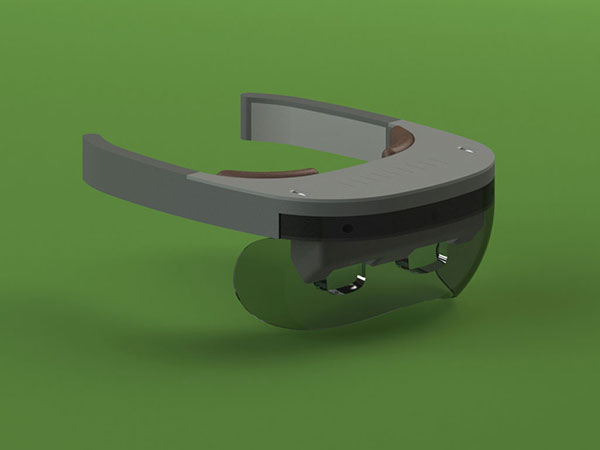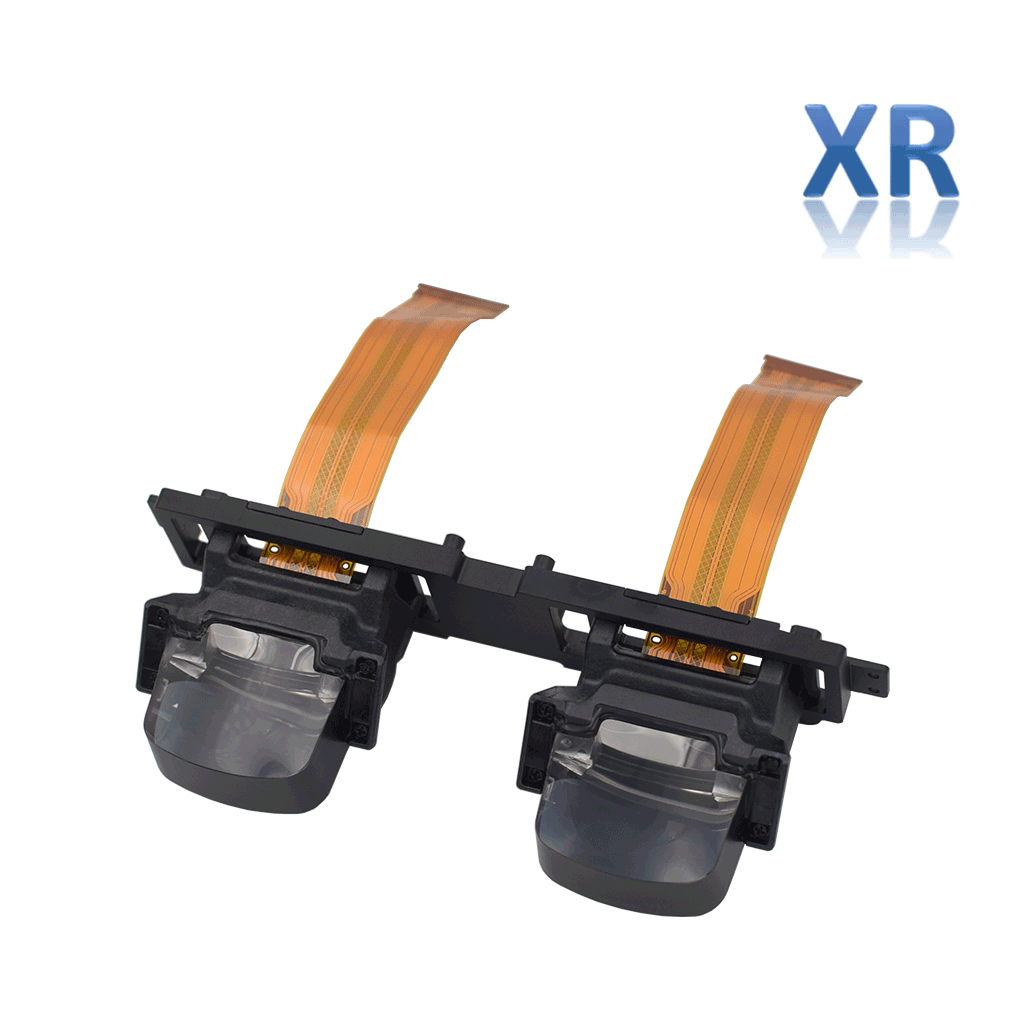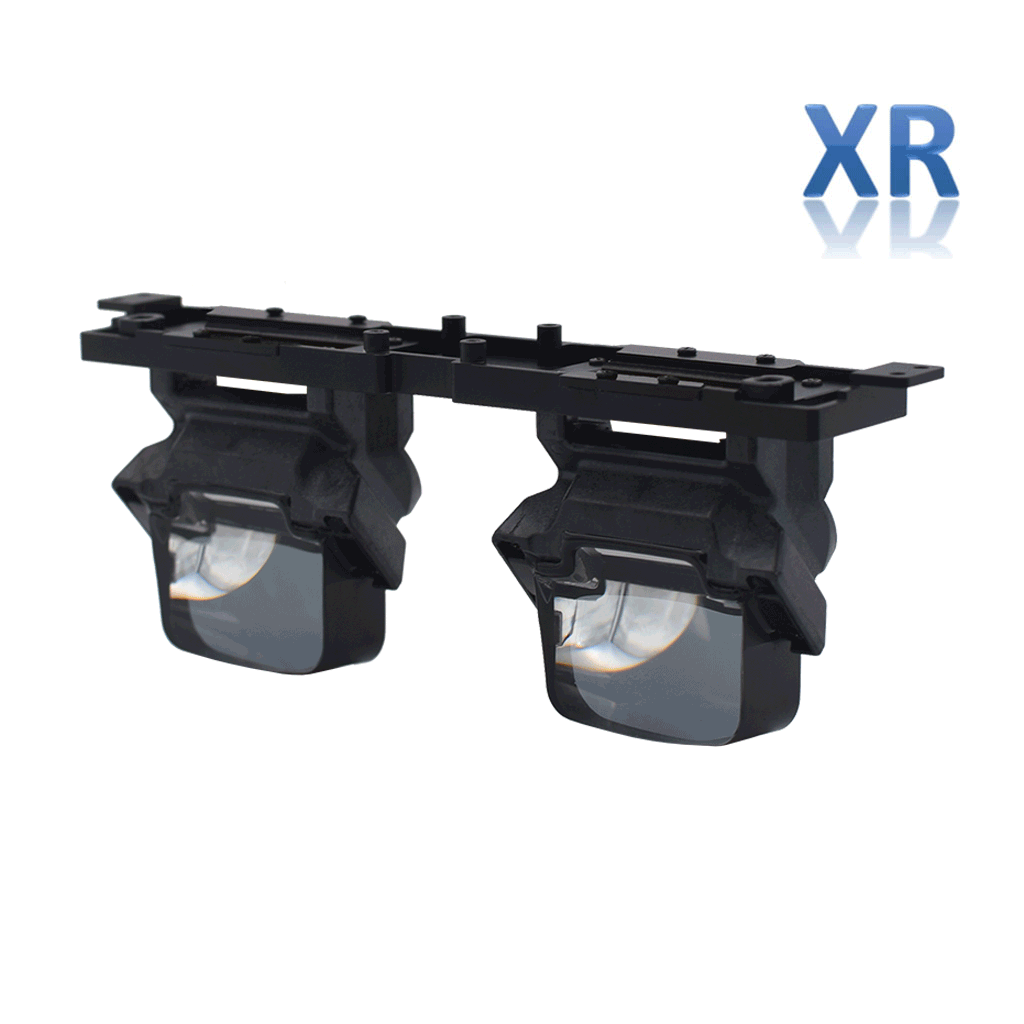FOV, e.g., 7.5° in 8x42 binoculars, denotes view width; exit pupil (42mm objective/8x mag=5.25mm) affects brightness; eye relief, 15-20mm (critical for glasses wearers), is lens-eye distance to avoid dark edges.
FOV: Your Window's View
In technical terms, FOV is the angular extent, measured in degrees, of the observable world that is visible at any given moment through the device. For mass consumers, a larger FOV, typically above 50 degrees diagonally, is critical for a compelling sense of immersion, especially in gaming and video playback, where it can increase the perceived realism by over 70%.
A wider FOV requires larger optical components, like waveguides or combiners. The simplified formula s = b + 2·r·tan(v/2)illustrates this perfectly: to increase the Field of View (v), you must also increase the size of the optical surface (s), assuming a fixed Eye Box size (b) and Eye Relief (r). A 40-degree FOV might require an optical element that is 15mm wide, but scaling that to a 60-degree FOV could demand an element wider than 25mm. This increase in size has a direct and substantial impact on the physical design. Larger, heavier optical components make it nearly impossible to create sleek, socially acceptable eyewear that weighs less than 100 grams. Instead, the device risks becoming bulky, applying more pressure on the bridge of the nose and leading to user fatigue over periods longer than 30 minutes.
Currently, the AR market reflects a clear divide driven by this trade-off. Most consumer-grade AR glasses on the market, like those designed for media consumption, feature a relatively modest FOV, often in the range of 30 to 45 degrees. This conservative approach prioritizes a compact form factor and a lower price point, often under $500. In contrast, enterprise-focused devices, such as those from Microsoft HoloLens or Magic Leap, push the FOV higher, reaching approximately 50-55 degrees, but as a direct consequence, their form factor is larger, their weight often exceeds 500 grams, and their price can be 5 to 10 times higher. This makes them suitable for professional tasks like complex equipment assembly or architectural visualization, where the ~20% increase in FOV provides a tangible ~35% improvement in task efficiency, justifying the trade-offs in comfort and cost.
A smaller FOV, such as 40° x 30°, is frequently sufficient for displaying critical data like schematics, inventory lists, or remote assistance instructions. This focused information display consumes less than 30% of the user's natural vision, which is a significant advantage for safety. It allows for a completely unobstructed peripheral view, increasing situational awareness by nearly 100% compared to a fully immersive VR headset. This is non-negotiable for a worker on a factory floor or in a warehouse, where a 0.5-second faster reaction time to a peripheral event can prevent an accident. The simpler optics of a smaller FOV system are also more robust, easier to manufacture with a >99% yield rate, and far less expensive to maintain and overhaul, reducing the total cost of ownership by an estimated 40% over a 3-year lifecycle.
Exit Pupil: The Light's Gateway
Its diameter, often between 3mm and 8mm in consumer AR devices, is a decisive factor for usability. If this gateway is smaller than the ~2-4mm entrance pupil of the human eye in typical indoor lighting, the image will appear to vignette, or "look through a keyhole," with even a 1mm misalignment causing a >30% loss in visible content. This makes a sufficiently large and stable exit pupil non-negotiable for a comfortable user experience, directly impacting the device's effective eye box and overall optical efficiency, which can range from a low <5% to an advanced >20% in current waveguide systems.
|
|
|
|
|---|---|---|
|
|
|
|
|
|
|
|
|
|
|
|
|
|
|
|
A small 4mm exit pupil might create an effective eye box with a tolerance of only about ±2mm of horizontal and vertical movement. This is unforgiving; a slight shift of the glasses on your nose by 3mm—say, from smiling or talking—will immediately cut off a significant portion of the image. In contrast, a larger 7mm exit pupil can enable an eye box with ±4mm of tolerance, allowing for natural head movements and ensuring a stable image for over 95% of users during a typical 1-2 hour usage session.
To increase the exit pupil diameter by 50% (e.g., from 4mm to 6mm), optical engineers often must correspondingly increase the size of the projection lens or the waveguide by a similar factor. This directly conflicts with the goal of creating sleek, lightweight glasses. A larger optical element increases the weight, potentially adding 10-15 grams, and the physical thickness of the temple arms by 2-3mm, making the device bulkier and less socially acceptable. Furthermore, for a given light source power, a larger exit pupil means the available light is spread over a wider area. This reduces the luminance (brightness per unit area). To compensate and maintain a brightness of, for instance, 2000 nits for clear daylight visibility, the micro-display's power consumption might need to increase by 30-50%, reducing battery life from a target of 4 hours down to under 3 hours.
In many designs, less than 5% of the light generated by the micro-display successfully travels through the waveguide and exits through the exit pupil to reach the user's eye. This means over 95% of the light is lost internally through absorption, scattering, or diffraction inefficiencies. This low efficiency forces a difficult choice: either use a extremely high-brightness micro-display, which can consume over 1 Watt of power and generate significant heat, or accept a dim image that is only usable indoors. Advanced diffraction gratings aim to improve this efficiency to 15-20%, which would either triple the perceived brightness or allow for a 60% reduction in display power for the same brightness level, directly extending battery life.
Eye Relief: Comfortable Viewing Distance
For most standard binoculars or riflescopes, this distance is relatively short, around 10-15mm. However, for AR glasses to be practical and comfortable for a diverse population, this requirement is far more demanding. A short 12mm eye relief might be usable for individuals with perfect vision, but it immediately excludes the approximately 64% of adults who wear prescription corrective eyewear. Their glasses add a 10-20mm gap between their eye and the AR lens, making a minimum 15mm of eye relief, and ideally 20-25mm, a necessity for universal design and user comfort over extended periods of more than 30 minutes.
- Standard Requirement: A minimum of 15mm is essential for basic compatibility with most eyewear.
- Ideal Range: 20-25mm provides a comfortable margin for all users, including those with bulky prescription frames.
- Physical Constraint: The front-most lens of the AR glasses typically cannot be positioned closer than 12-15mm from the average user's face without touching eyelashes or eyebrows.
The primary challenge with designing for a long eye relief is its inverse relationship with the device's field of view (FOV) and the size of its optical components. This is governed by the optical formula s = b + 2·r·tan(v/2), where the size of the optical surface (s) increases directly with a longer eye relief (r). To maintain a target 40-degree diagonal FOV, increasing the eye relief from a compact 12mm to a glasses-compatible 20mm can force the primary optical element to be up to 30-40% larger in diameter. This increase of just 8mm in eye relief can translate to an increase in the optical component's width from 18mm to nearly 25mm. This has a direct and substantial impact on the industrial design, pushing the temples of the glasses further from the head, increasing the weight by 10-15 grams, and making the device feel bulkier and less stable. This is a key reason why many early AR headsets, prioritizing a wide 50+ degree FOV, often featured uncomfortably short eye relief, leading to a high rate of user fatigue within the first 20 minutes of use.
For the estimated 2.5 billion people globally who need vision correction, sufficient eye relief is the difference between a usable tool and an immediate rejection. A user with prescription glasses has an effective eye relief that is the sum of the AR device's design distance plus the air gap created by their own frames. If the AR glasses are designed with a 15mm eye relief, but the user's glasses create a 5mm gap, the functional eye relief for the optical system becomes 20mm. If the device was not engineered to support this, the user will experience severe vignetting, losing up to 50% of the promised FOV. This is why professional-grade AR devices, aimed at enterprise and healthcare markets where users wear safety glasses or prescription lenses, explicitly design for an eye relief of 20-25mm. This specification alone can increase the complexity and unit cost of the optical engine by 15-20%, but it is a non-negotiable investment for achieving a >90% user acceptance rate in a workforce of over 1000 employees.
The interplay between eye relief and the eye box is another critical engineering trade-off. The eye box is the three-dimensional volume where the eye can move and still see a full image. As the eye relief increases, the "cone" of light projecting from the eyepiece becomes narrower. To maintain a usable eye box size of, for instance, 8mm x 8mm at a 15mm eye relief is a manageable task. However, maintaining that same 8mm eye box size at a 25mm eye relief requires a significantly larger exit pupil and more complex optics at the eyepiece, often demanding larger lenses or more precise (and expensive) fabrication techniques. The tolerance for vertical and horizontal misalignment drops from a comfortable ±4mm to a restrictive ±2mm, meaning the glasses must fit perfectly and not slip at all. This is why devices with longer eye relief often incorporate adjustable nose pads and temple arms with a >20-degree range of fit adjustment to ensure a stable and precise fit for the 95th percentile of head shapes.
How These Three Work Together
Imagine designing a car where trying to increase top speed (FOV) directly forces you to enlarge the fuel tank (optical size), which then reduces passenger legroom (Eye Relief comfort). This is governed by the equation s = b + 2·r·tan(v/2), where the size of the optical component (s) is determined by the Eye Box (b), Eye Relief (r), and FOV (v). For instance, targeting a 50-degree FOV with a generous 12mm x 10mm eye box at a 20mm eye relief demands an optical combiner over 25mm wide.
|
|
|
|
|
|---|---|---|---|
|
|
|
|
|
|
|
|
|
|
|
|
|
|
|
Pursuing a 60-degree FOV for a gaming-focused AR headset is a primary goal, as it can increase user immersion metrics by over 70%. However, according to the optical formula, this wide FOV (v) exerts tremendous pressure on the other variables. To keep the device from becoming impractically large, engineers are often forced to compromise on the eye relief (r), shortening it to a tight 12-15mm. This immediately creates a usability issue for the approximately 64% of potential users who wear corrective lenses, as their glasses would prevent them from getting their eyes close enough to see the full image.
A primary design goal is to create a large exit pupil, ensuring a wide eye box that allows for ±4mm of horizontal and vertical head movement without image cut-off. This robustness is crucial for enterprise applications where a worker might use the device for a full 8-hour shift. However, generating a large, bright exit pupil is incredibly costly in terms of light. In a common waveguide-based system, which might already have a low 3-5% optical efficiency, increasing the exit pupil diameter from 4mm to 6mm spreads the available light over an area that is 125% larger. To maintain a minimum usable brightness of 1000 nits for an office environment, the power delivered to the micro-display might need to jump from 0.8 Watts to over 1.2 Watts, a 50% increase. This single adjustment could slash the projected battery life from a target of 4 hours down to under 2.5 hours, a reduction of nearly 40%.
For the enterprise market, the optimal balance often skews towards reliability and comfort over raw immersion. A business-focused AR device, used for tasks like remote assistance or logistics, typically prioritizes a 20-25mm eye relief to accommodate safety glasses and a robust >10mm eye box tolerance to account for constant head movement. This pragmatic approach accepts a more modest 30-40 degree FOV, which is still sufficient to display a virtual 24-inch monitor at a 2-meter viewing distance.
Read more

DisplayModule published a XR development Kit. Do It Youself yours XR world!

DisplayModule introduces some concepts of AR glasses parameters 02



Leave a comment
This site is protected by hCaptcha and the hCaptcha Privacy Policy and Terms of Service apply.